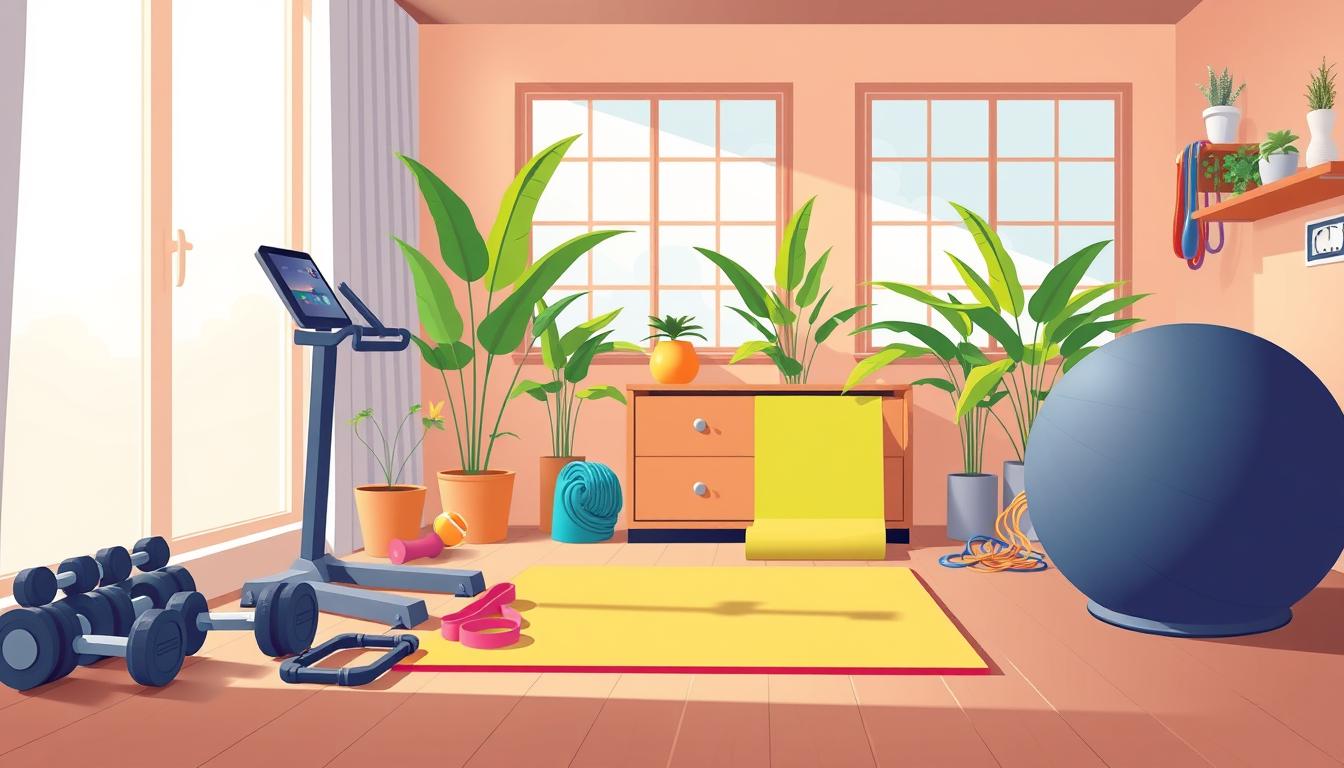The Ultimate Guide to Home Workouts: Getting Fit Without a Gym Membership
Are you ready to change your body without going to the gym? Home workouts are all the rage, and for a good reason. A huge 78% of fitness fans say home workouts save them time compared to the gym. But can you really get fit without expensive gear or a gym membership?
Let’s explore the world of home workouts, where ease meets effectiveness. With 65% of people preferring to exercise alone, it’s clear home fitness is more than a trend. It’s a lifestyle shift.
Imagine cutting fitness costs by up to 70% by working out at home. We’ll show you how to make a great workout routine that fits your life and wallet. Plus, we’ll reveal why 82% of home fitness lovers prefer High-Intensity Interval Training (HIIT) for burning fat.
Get set to discover the secrets of home fitness, improve your mental health, and join the 60% who’ve succeeded with online workouts. This guide is for everyone, whether you’re new to fitness or already in the game. You can reach your goals without needing a gym.
Introduction to Home Workouts
Home workouts are now more popular than ever. They offer a great way to stay fit without needing a gym membership. This section will look at the benefits of home workouts, common challenges, and how to set realistic goals.
Benefits of working out at home
Working out at home has many perks. You save time and money by avoiding gym fees and long commutes. You can also exercise in private, without worrying about what others think. Plus, you can work out whenever it’s best for you.
Overcoming common obstacles
Starting a home workout routine can be tough. Limited space and equipment might seem like big hurdles. But, there are creative solutions like bodyweight exercises or resistance bands. If you struggle with motivation, try setting a regular schedule and finding workout buddies online.
Setting realistic goals
Setting achievable fitness goals is important for success. Start with small goals and gradually increase the intensity. Beginners should aim for 150 minutes of moderate activity each week. Remember, consistency is key. Even short workouts of 10-15 minutes can be beneficial. Keep track of your progress to stay motivated and adjust your goals as needed.
| Intensity Level | Description | Weekly Goal |
|---|---|---|
| Low | Can easily talk or sing | 150+ minutes |
| Moderate | Can speak in full sentences | 150 minutes |
| Vigorous | Too breathless for full sentences | 75 minutes |
Understanding these key points about home workouts will help you begin your fitness journey. The most important thing is to find a workout routine you can stick to.
Creating Your Home Workout Space
Setting up a home gym is a big step for your fitness journey. A well-designed space can boost your motivation and make working out a daily habit. Let’s look at how to create the perfect workout environment at home.
First, pick a dedicated spot for your home gym. It could be a spare room, basement, or a corner of your living area. The key is to be consistent – having a set place for exercise helps build routine. In fact, 72% of Americans upgraded their home workout spaces during the pandemic, showing the growing trend of at-home fitness.
When planning your exercise area, think multi-functional. Invest in versatile equipment like adjustable weights or resistance bands. These take up less space and offer more workout options. Remember, the global fitness equipment market hit $11.5 billion in 2023, so there’s plenty of choice out there.
- Use storage racks to keep your space tidy
- Add mirrors to check form and make the room feel bigger
- Ensure good lighting and ventilation for comfort
Your workout environment should inspire you. Personalize it with motivational posters or a progress chart. Don’t forget about music – the right tunes can really pump up your workout. Aim for songs with 130-140 beats per minute for strength training sessions.
Remember, consistency is key in any fitness plan. With a well-designed home gym setup, you’re setting yourself up for success. Whether you’re aiming to lose weight or gain muscle, your personalized exercise area will be your ticket to achieving those goals.
Essential Equipment for Home Workouts
Setting up a home gym can change your fitness journey. The right equipment lets you get great results at home. Let’s look at key items for bodyweight and resistance training.
Bodyweight Exercises
Bodyweight training is a great start. It needs no equipment and can be done anywhere. Try push-ups, squats, and planks to work many muscles.
Resistance Bands
Resistance bands are versatile and affordable. They offer strength gains like weights but save space. They’re good for all levels, boosting your home workouts.
Dumbbells and Kettlebells
Dumbbells or kettlebells add variety to your workouts. Choose weights that challenge you but allow proper form. Beginners might start with 10 kg dumbbells to build muscle.
Yoga Mat and Foam Roller
A yoga mat makes floor exercises and stretching comfy. Use a foam roller for recovery and flexibility. These are key for a complete home workout.
| Equipment | Approximate Cost | Benefits |
|---|---|---|
| Resistance Bands | $20-$30 | Versatile, portable, great for strength training |
| Dumbbells (10kg pair) | $40-$60 | Ideal for muscle building, various exercises |
| Yoga Mat | $15-$25 | Comfortable surface for floor exercises |
| Foam Roller | $20-$30 | Aids in recovery, improves flexibility |
You don’t have to buy everything at once. Start simple and add more as you go. Using these tools well will help you reach your fitness goals without a gym.
Designing Your Workout Plan
Creating a good workout plan is crucial for reaching your fitness goals. A balanced routine includes strength training, cardio, and flexibility exercises. Let’s explore the basics of planning workouts and making a fitness schedule that fits your lifestyle.
Begin by setting achievable goals. Gaining muscle at a healthy rate is about 0.5 pounds per week. Losing weight should be 0.5-1% of your body weight each week. Aim for 150 minutes of moderate or 75 minutes of vigorous exercise weekly.
Your fitness plan should include:
- 2-4 workout sessions per week, each lasting 30-45 minutes
- A mix of strength training and cardio exercises
- Rest days for recovery
Focus on compound exercises in your routine. These exercises work many muscles at once. They boost strength, endurance, and flexibility.
Remember, consistency is key. Even three 10-minute bouts of exercise throughout the day can be as effective as one 30-minute session.
Use the FITT principle to plan your workouts:
| Component | Description |
|---|---|
| Frequency | How often you exercise |
| Intensity | How hard you work during exercise |
| Time | Duration of each session |
| Type | Kind of exercise performed |
Don’t forget to warm up and cool down for 5 minutes to reduce injury risk. With careful planning and a balanced schedule, you’ll reach your health and fitness goals.
Bodyweight Exercises for Strength Training
Bodyweight strength training is a great way to build muscle and get fit without any equipment. You can do just as well at home as you would at the gym. Let’s look at some key exercises for a full-body workout.
Push-ups and Variations
Push-ups are a key part of bodyweight training. They work your chest, shoulders, and triceps. Beginners can start with wall push-ups or knee push-ups.
As you get better, move to regular push-ups. Then, try diamond push-ups or clap push-ups for more challenge.
Squats and Lunges
Squats and lunges are great for your lower body. Bodyweight squats work your quads, hamstrings, and glutes. Lunges target similar muscles and improve balance.
Try reverse lunges or walking lunges for something different.
Planks and Core Workouts
Core workouts are essential for strength and stability. Planks are great for your entire core. Start with a 15-second hold and increase it as you get stronger.
For more challenge, try side planks or mountain climbers.
| Exercise | Target Muscles | Beginner Reps | Advanced Reps |
|---|---|---|---|
| Push-ups | Chest, Shoulders, Triceps | 5-10 | 20-30 |
| Squats | Quads, Hamstrings, Glutes | 10-15 | 30-50 |
| Plank | Core, Back | 15 seconds | 60+ seconds |
Remember, proper form is crucial in home strength exercises. Start with 2-3 sets of each exercise, 2-4 times a week. As you get stronger, increase reps or try more challenging variations.
Combine these exercises for a full-body workout. It will build strength and improve fitness, all from home.
Cardiovascular Workouts at Home
Boost your aerobic fitness with effective home cardio exercises. Indoor cardio workouts are key to maintaining heart health and overall well-being. The American College of Sports Medicine recommends 150-300 minutes of moderate physical activity weekly.
Start with beginner-friendly moves like jumping jacks or marching in place. These simple yet effective exercises elevate your heart rate and serve as excellent warm-ups. As you progress, try intermediate exercises to intensify your workout and get your body moving more.
For advanced fitness enthusiasts, incorporate full-body exercises like burpees or mountain climbers. These challenging moves boost heart rate and endurance levels while engaging multiple muscle groups.
Creating Your Home Cardio Routine
Design a circuit workout by choosing exercises that match your fitness level. Perform each move for 30-60 seconds, rest briefly, then repeat. This approach maximizes your indoor cardio workout efficiency.
| Fitness Level | Exercises | Duration |
|---|---|---|
| Beginner | High knees, Butt kicks, Jumping jacks | 30 seconds each |
| Intermediate | Squat jumps, Plank jacks, Lateral shuffles | 45 seconds each |
| Advanced | Burpees, Mountain climbers, Rotational jacks | 60 seconds each |
Remember to warm up before and cool down after your home cardio exercises. This practice prevents injuries and enhances your overall aerobic fitness. If you have health conditions, consult a healthcare provider before starting new indoor cardio workouts.
The Ultimate Guide to Home Workouts: Getting Fit Without a Gym Membership
Home workouts are now more popular than ever. They’re easy to do and get results. Whether you’re new to fitness or have been doing it for years, there’s a routine for you. Let’s look at routines for different fitness levels and how to keep getting better.
Beginner Home Workout Routine
Start with simple exercises if you’re new to fitness. A beginner routine might include:
- 10 squats
- 5 push-ups (on knees if needed)
- 30-second plank
- 10 lunges per leg
- 30 jumping jacks
Do this circuit 2-3 times, resting between sets. As you get better, do more reps and add resistance bands for a harder workout.
Intermediate Home Workout Routine
If you have some fitness experience, try this routine:
- 15 burpees
- 12 dumbbell rows (each arm)
- 20 mountain climbers
- 15 dumbbell squats
- 1-minute jump rope
Do 3-4 rounds of this circuit. Adjust the weights and reps to fit your fitness level.
Advanced Home Workout Routine
For those who want a real challenge:
- 10 plyometric push-ups
- 20 Bulgarian split squats (each leg)
- 15 pull-ups or inverted rows
- 30-second wall sit
- 20 box jumps
Do 4-5 rounds of this tough circuit. Remember, proper form is important for getting better and staying safe.
Consistency is key, no matter your fitness level. Keep track of your progress, stay hydrated, and listen to your body. With hard work and these home workout routines, you can reach your fitness goals without going to the gym.
Nutrition Tips for Home Workout Success
Proper nutrition is key for home workout success. A healthy diet fuels your body, supports muscle growth, and helps with recovery. Here are some tips for a diet that boosts your fitness journey.
You can’t outrun your fork. In fact, 90% of health and fitness success comes from what you eat. First, use a calorie calculator to figure out your daily calorie needs. This helps you know how much food you need to support your fitness goals.
Make sure your meals are balanced, including all food groups. Protein helps repair muscles, and carbs give you energy for workouts. Also, include healthy fats and lots of fruits and veggies in your diet.
“Abs are made in the kitchen, not in the gym.”
Controlling your portions is important for healthy eating. Here’s a guide to help you measure your food:
| Food Item | Portion Size | Visual Reference |
|---|---|---|
| Protein (meat, fish) | 3-4 oz | Deck of cards |
| Carbohydrates (rice, pasta) | 1/2 cup | Tennis ball |
| Vegetables | 1 cup | Baseball |
| Fruits | 1 medium | Light bulb |
Drink water before, during, and after your workouts to stay hydrated. After your workout, eat a balanced meal or snack to help with recovery and muscle growth.
Staying Motivated and Accountable
Staying motivated for home workouts can be hard. But, with the right strategies, you can keep going and hit your fitness goals. Let’s look at some ways to boost your motivation and stay accountable.
Setting a Schedule
Make a workout plan that fits your life. Schedule exercise time in your calendar, just like any other important meeting. This makes fitness a priority and helps you stay consistent. Remember, it’s okay to adjust your routine sometimes.
Tracking Progress
Tracking your workouts is crucial for staying motivated. Use a fitness app or journal to log your exercises. Write down your achievements, no matter how small. Studies show that tracking progress can make you 42% more likely to stick with your fitness routine.
Finding Workout Partners Online
You don’t have to work out alone. Join online fitness communities or virtual workout groups. Having a support system can really boost your motivation and keep you accountable. In fact, exercising with a partner can make you 95% more likely to finish your workout program.
| Motivation Strategy | Impact on Workout Consistency |
|---|---|
| Setting Clear Goals | 30% increase |
| Progress Tracking | 42% increase |
| Online Workout Partners | 95% program completion rate |
By using these strategies, you’ll be on your way to a consistent and effective home workout routine. Remember, every step you take is important in your fitness journey!
Incorporating HIIT into Your Home Workouts
HIIT workouts are a game-changer for home fitness enthusiasts. These exercises are quick and effective, giving great results in short sessions. They are perfect for busy people, burning calories and boosting metabolism in just 20 to 30 minutes.
To start your HIIT journey, aim for 2-3 sessions per week. Begin with a 5-minute warm-up, then dive into the main routine. A typical HIIT workout includes 5 exercises performed in 20-second bursts with 10-second rest periods, repeated for 4 rounds.
No gym? No problem! HIIT is versatile and requires minimal equipment. Use your body weight or simple tools like dumbbells, resistance bands, or a jump rope. Mix it up with exercises like burpees, mountain climbers, and high knees to keep your workouts fresh and challenging.
Benefits of HIIT
- Burns calories efficiently
- Improves cardiovascular health
- Increases endurance and strength
- Enhances cognitive function
- Sculpts muscle effectively
Remember to allow at least one day of rest between sessions for proper recovery. As you progress, adjust the intensity and duration to match your fitness level. HIIT’s adaptability makes it suitable for beginners and advanced athletes alike.
| Workout Duration | Exercises | Equipment |
|---|---|---|
| 12-15 minutes | Bodyweight squats, Push-ups, Lunges | None |
| 20-30 minutes | Kettlebell swings, Dumbbell thrusters, Jump rope | Kettlebell, Dumbbells, Jump rope |
| 30-45 minutes | Rowing intervals, Medicine ball slams, Burpees | Rowing machine, Medicine ball |
Incorporate HIIT into your home routine and experience the transformative power of high-intensity training. These time-efficient exercises will help you achieve your fitness goals faster, all from the comfort of your living room.
Yoga and Stretching Routines for Flexibility
Adding yoga and stretching to your home workouts can really help with flexibility and overall health. A good flexibility program uses different methods to work on various muscles. This helps improve how far you can move your joints.
Nerd Fitness Prime has a 30-day “Flexibility for the Inflexible” challenge. It includes three main stretches: Toe Touch, Back Scratch, and Butterfly Stretch. This 4-week plan uses Active Range of Motion, Pulses, and Holds to slowly increase flexibility.
To see how you’re doing, rate yourself from 1 to 10 for each stretch. The program gives you three 20-minute videos each week. It shows that stretching every day isn’t needed to see progress.
| Week | Focus | Technique |
|---|---|---|
| 1 | Foundations of movement | Active Range of Motion |
| 2 | Identifying flexibility limits | Pulses |
| 3 | Exploring movement adjustments | Holds |
| 4 | Incorporating strength-building exercises | Combined techniques |
For a full home yoga practice, check out 15 routines for different body parts. For example, Downward Facing Dog stretches your shoulders, hamstrings, calves, and foot arches. Each pose has detailed instructions and breathing tips to get the most out of it.
Remember, flexibility training can be adjusted. Use yoga blocks for support if you need to. By sticking with these stretches, you’ll see better flexibility, strength, and balance in your everyday life.
Using Technology to Enhance Your Home Workouts
The fitness world has gone digital, and it’s time to hop on board! With 80% of people preferring online resources for home workouts, technology has become a game-changer. Let’s explore how you can leverage fitness technology to supercharge your exercise routine.
Fitness Apps and Online Classes
Workout apps and online fitness classes have taken the world by storm. Apps like MyFitnessPal and Noom have seen a 45% increase in user engagement. These digital tools offer tailored workouts, nutrition tracking, and progress monitoring. With 2 Gig internet from Ritter Communications, streaming your favorite online classes is faster than ever.
Virtual Personal Training
Virtual trainers are the new fitness buddies. Platforms like Apple Fitness+ and Nike Training Club bring expert guidance right to your living room. These services cost a fraction of gym memberships, ranging from $15 to $30 per month compared to the average $58 for traditional gyms. Plus, 63% of people love the convenience of working out at home.
Wearable Fitness Trackers
Wearable tech is a must-have for fitness enthusiasts. Devices like Fitbit and Apple Watch help 75% of users monitor their health metrics effectively. These gadgets, ranging from $100 to $500, provide real-time feedback on your workouts. They sync with other smart gym equipment, allowing 78% of users to benefit from data-driven insights and personalized workout plans.
Source Links
- The Ultimate Guide to Home Workouts: How to Build Muscle Without the G
- Home Workout and Fitness Tips: Exercising without the Gym
- The Ultimate Home Workout for Each Fitness Level
- The 10 Best at Home Workouts (No-Equipment!) | Nerd Fitness
- 8 At-Home Exercises to Stay Fit Without the Gym
- How to Start Exercising and Stick to It – HelpGuide.org
- Creating a Home Gym: The Ultimate Guide to Setting Up Your Workout Space – Dustland Move-to-earn Blog
- How to Plan and Design a Home Workout — The Ultimate Guide
- The Ultimate Guide to Building a Home Gym
- Best Home Gym Equipment You’ll Actually Use
- Home Workout: Equipment You Need
- The Ultimate Guide to At-Home Workout Equipment:
- How To Build Your Own Workout Routine (Plans & Exercises)
- An Ultimate Guide To Basic Home Workout Routine – Onsurity
- A complete guide on how to create your own workout plan from scratch (no expensive trainer required)
- 31 Bodyweight Exercises to Pack on Muscle at Home
- Bodyweight Workout for Beginners (20-Minute at Home Routine)
- The 20 best cardio exercises to do at home
- Cardio Exercises at Home: 19 Moves for Every Fitness Level
- Ultimate Home Workout Guide for Beginners: Start Today
- How to Get Fit at Home: Exercising without a Gym
- The Ultimate Guide to At-Home Workouts
- Stay in Shape Without Leaving the House (Get Fit at Home) | Nerd Fitness
- How to Start Exercising: A Beginner’s Guide to Working Out
- Everything You Need to Know About Working Out at Home
- Get Fit at Home: Your Ultimate Guide to Home Workouts
- How To Stay Consistent and Motivated with Exercise – Mommy Gone Healthy | A Lifestyle Blog by Amber Battishill
- How to Achieve a HIIT Workout at Home
- HIIT Workouts At Home: Top Tips & Exercise Routines
- HIIT Training Can Get You Results Faster Than Running On A Treadmill
- How to Improve Flexibility (in 30 Days) | Nerd Fitness
- You Should Hold These Yoga Stretches For 30 Seconds—Here’s Why
- Your Ultimate Guide to Home Workouts
- Transform Your Fitness Journey: The Ultimate Guide to Fitness Streaming Technology | Life by Daily Burn
- Totally Revamp Your Workout With The Ultimate Guide to Creating a Smart Home Gym







